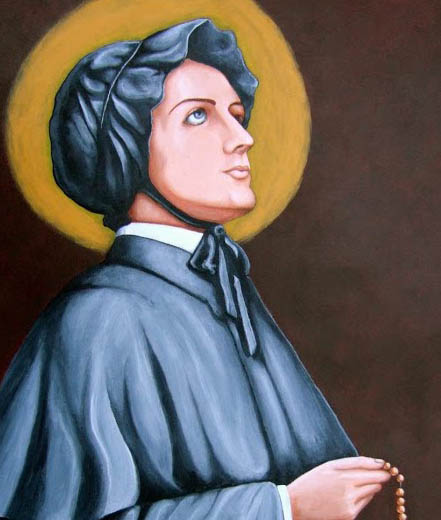Elizabeth Ann Seton
Founder of the Daughters of Charity in the US

Elizabeth Ann Bayley was born on August 28, 1774, in New York City.
In 1774, the aura of the revolution was penetrating the soul of the American colonies. Beleaguered by taxation without representation imposed upon them by their mother country, the colonists were determined to gain their independence from England. . . even if it meant war. It was into a world permeated with the spirit of independence and revolution that Elizabeth was born. Her father was a respected physician; her mother was the daughter of an Episcopalian rector. When Elizabeth was three years old, her mother died giving birth. Although her father remarried, Elizabeth and her sister were sent to live with relatives in the country, but in spite of difficult and lonely times, Elizabeth demonstrated a courageous spirit.
Elizabeth Marries and Has a Family
In her late teens, Ann met William Magee Seton. They fell in love and married when Elizabeth was 19 years old (Will was 25). Within seven years, they had five children: Anna Marie, William, Richard, Catherine and Rebecca. In the course of time, Will’s health began to decline due to tuberculosis. He died while in Italy in 1803. At age 29, Ann was a widow with children, and she was welcomed in Italy into the home of the Filicchi family, two business brothers and friends of the Setons. During her stay, Elizabeth was introduced to Catholicsim, and (after returning to New York) became a Catholic herself.
Elizabeth’s Faith Creates Life Challenges
Her conversion to Catholicism created many difficulties for Elizabeth. Her family and many of her friends abandoned her. At the beginning of the 19th century, Catholics in the United States numbered fewer than 30,000. Most Catholic families were of the immigrant Irish and Italian working class, and they were a despised and barely tolerated minority. However, throughout the century, the Catholic church would gradually become a respected ecclesiastic body influencing the moral fiber of the nation. This was due initially to the leadership of Archbishop John Carroll in Baltimore, the first Bishop of the United States.
Archibshop Carroll’s Influence
Education was a high priority for Bishop Carroll. Father William Dubourg—a Frenchy Sulpician priest in the diocese—invited Elizabeth to Baltimore to open a small school for poor immigrant girls, and since Maryland was relatively free of anti-Catholic sentiment, Elizabeth chose to take the journey there.
The Women-Desired Community, Charity was Born
Ann Elizabeth Seton opened a small school for girls and invited other women to join her. Along with these women, Elizabeth desired to form a community of religious women. The foundation place for this community was deemed to be Emmitsburg, Maryland, some 50 miles west of Baltimore. On July 31, 1809, the Sisters of Charity of St. Joseph’s was born. The same revolutionary spirit that inflamed Louise and Vincent burned in the heart of Elizabeth Ann Seton more than a century later when she reached Emmitsburg, Maryland, on June 21, 1809. This was the first native community of religious women in the United States.
Father Dubourg became the spiritual director of the Sisters. He strongly encouraged Elizabeth to adopt the rules of the Daughters of Charity in France, his desire that the two communities would unite. The rule was brought over to the United States and adopted by Elizabeth and her Sisters.
Elizabeth Ann Seton’s community had spread rapidly.
There was an academy and village school in Emmitsburg, Maryland, as well as an orphanage and school in Philadelphia, and an orphanage in New York. Eventually, the works of her community spread throughout North America. The affiliation with the Daughters of Charity in France took place in 1850, and California beckoned them by 1852. Elizabeth Seton lived until January 4, 1821, when she died of tuberculosis.
The Civil War
The Daughters and Sisters of Charity played a prominent role during the Civil War as nurses and aid workers, providing compassion in an otherwise violent and painful epoch. Some worked in the cities where they were missioned, while others traveled from battlefield to battlefield, north and south. They continued Mother Seton’s ministry of charity, bringing solace and healing to the wounded of both armies, sometimes at their own peril. The war came to Emmitsburg in late July 1863. The armies of the Potomac and Northern Virginia succeeded one another at St. Joseph’s. Like Elizabeth Ann Seton, the Sisters during this battle sought out and served those in need. Approximately 40 years after Mother Seton’s death in 1821, her home was the site of the Union encampment in 1863. St. Joseph’s House, now known as Mother Seton’s White House was where Union officers conducted a war council to prepare for the battle of Gettysburg.


